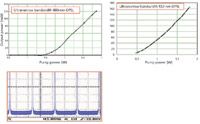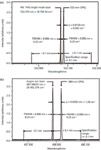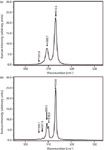High-Resolution Raman Spectroscopy with Optically Pumped Semiconductor Lasers
A report on first results of the successful application of optically pumped semiconductor lasers in Raman spectroscopy of condensed-phase samples

The performance of ultranarrow bandwidth optically pumped semiconductor lasers in Raman spectroscopy is described in this column. Several examples of Raman spectra of liquid and solid samples demonstrate the very successful use of these lasers as excitation sources for high-resolution Raman spectroscopy of samples in the condensed phase.
In the past, typical economic laser sources for Raman spectroscopy with fixed wavelengths as well as narrow bandwidth were gas lasers (He-Ne, He-Cd, argon ion, krypton ion, or mixed argon and krypton ion) and Nd:YAG or Nd:YVO4 lasers (fundamental-wavelength as well as frequency-doubled). He-Ne lasers (used mainly at 633 nm) suffer from power restrictions, typically up to 50 mW. The argon and krypton ion lasers come with the advantage of multiline operation (for example, 351, 458, 488, and 514 nm). However, their large size, low efficiency, high power consumption and therewith high heat dissipation, background discharge light, limited lifetime, and high costs pose significant disadvantages to system builders. Crystal-based diode pumped solid state (DPSS) lasers (for example, Nd:YAG or Nd:YVO4 ) allow for high beam quality, power stability, and low noise. But because of the physics of their laser media they are restricted to a few discrete wavelengths (such as 1064 or 532 nm).
Diode lasers are the most common laser type in use today applied in every-day products such as CD and DVD players and laser printers. Concerning size, efficiency, lifetime, and economy, typically (not always) no other laser type can compete. The laser beam is elliptical, highly divergent, and astigmatic, therefore it often needs beam shaping. The laser wavelength and mode spectrum are dependent on temperature and power pump current, respectively. The wavelength consistency from unit to unit is low. And, let's not forget the amplified spontaneous emission (ASE) background light. For spectrally demanding or narrow-linewidth applications these lasers have to be line narrowed (for example, via distributed feedback [DFB] or distributed Bragg reflector [DBR] techniques, external volume Bragg gratings, and open-resonator designs such as Littrow or Littman-Metcalf arrangements) and need temperature stabilization to avoid wavelength drifting. For applications such as Raman spectroscopy, their ASE background must be suppressed by additional filters.
To overcome the disadvantages of ions, DPSS and optically pumped semiconductor lasers (OPSLs) were developed and introduced in 2001. Their unique features such as power scalability and wavelength flexibility, their excellent beam parameters, power stability, and reliability gave this pioneering technology access to a wide range of applications in life sciences, semiconductor inspection, graphic arts, and forensics. However, these lasers did not operate at a single frequency and hence were not suited for applications demanding a narrow bandwidth or long coherence length such as high-resolution Raman spectroscopy and Brillouin scattering.
Ultranarrow-bandwidth OPSLs with a bandwidth of <1.5 MHz are available (Sapphire SF series, Coherent). The ultranarrow bandwidth, high power stability (<2% ptp), low noise (<0.25% rms), and high beam quality make the single-frequency OPSLs an excellent laser source for high-resolution Raman excitation. This column installment reports on first results of the successful application of such lasers in Raman spectroscopy of condensed-phase samples. Gas-phase spectra will be investigated in due course.
OPSL Technology
The key component of an OPSL is a vertical-cavity surface-emitting laser type thin semiconductor disk, which is typically grown on a GaAs substrate (see Figure 1). The disk consists of two sections: a gain medium at the top and a mirror medium underneath. The gain medium is a layer structure designed to efficiently absorb near-IR pump light and emit laser light at a wavelength determined by the size and stoichiometry of the quantum wells contained in these layers. It is pumped by a standard single-emitter diode laser. The mirror medium comprises a sequence of epitaxially grown high- and low-refractive index layers that form a DBR. This DBR serves as the laser's rear cavity mirror.

Figure 1: Schematic of an optically pumped semiconductor laser (OPSL). Pump light from a laser diode is imaged into the front surface of a vertical-cavity surface-emitting laser type chip. This monolithic III-V semiconductor structure contains layers of tertiary quantum wells (InGaAs) alternated between binary (GaAs) layers optimized to efficiently absorb pump radiation. Behind these absorption and emission layers are several alternating high index and low index layers that act as a low-loss DBR mirror optimized for the specific OPSL fundamental. The InGaAs-based OPSLs can be designed to produce output wavelengths of 700â1200 nm. Internal frequency doubling extends this operation through most of the visible spectrum (350â600 nm).
In contrast to a diode laser, the resonator output mirror is not the exit face of the chip but rather an external mirror. This open-cavity structure allows for laser beam shaping, the insertion of optical components for frequency doubling, mode or frequency selection, and stabilization.
The extended cavity design of the OPSL and the features of the active medium and the pump conditions allow for the generation of a high-quality, diffraction-limited, single transverse mode (TEM00 ) beam. With corresponding frequency-selecting elements, a stable single-frequency operation also at high output powers is achieved.

Figure 2: Upper two panels: Output power of a 488-nm and a 532-nm OPSL (Coherent Sapphire SF series) as function of pump power. Lower panel: the mode scan for the 488-nm laser. Independent of output power the lasers are in stable single-longitudinal mode operation with a linewidth below 1.5 MHz.
In Figure 2, in the upper two panels, the output power of a 488-nm and a 532-nm Sapphire SF laser are given as a function of pump power; in the lower panel the mode scan for the 488-nm laser is shown. Independent of power, the lasers operate in a stable single-longitudinal mode with a linewidth below 1.5 MHz.
Crystal-based solid-state lasers such as Nd:YAG or Nd:YVO4 can provide laser light only at a few discrete wavelengths. In contrast, the emission wavelength of the OPSL is determined primarily by the stoichiometry and physical dimensions of the quantum well structures in the gain chip. As a consequence, the InGaAs-based OPSLs can be designed to produce output wavelengths anywhere from 700 nm to 1200 nm. Internal frequency doubling as shown in Figure 1 extends this operation through most of the visible spectrum (350 nm to 600 nm).
Intracavity-doubled continuous wave lasers often suffer from large chaotic power fluctuations called "green noise" (because these effects were first detected in frequency-doubled Nd:YAG lasers at 532 nm). The very short excited-state lifetime for the OPSL quantum wells (for example, approximately 5 ns compared to approximately 100 µs for Nd:YVO4 ) and its longitudinal-mode characteristics eliminate this effect, which is one of the reasons for the excellent noise characteristics of an OPSL.
Raman Spectrosopy with OPSLs
Raman spectra of samples in the condensed phase were excited by means of ultranarrow linewidth OPSLs currently available in wavelengths of 488 nm and 532 nm with output powers of 20–100 mW and 20–150 mW, respectively (Coherent). All Raman spectra shown below were taken with a 1-m Jarrell-Ash double monochromator where only the first stage was used; the middle slit had been removed and a Peltier-cooled CCD camera (Wright Instruments Ltd., 1024 × 256 pixels) was attached to the spectrometer. To overcome the limited spectral resolution because of the fairly large pixel size (approximately 27 µm), the spectrum obtained in the focal plane of the first stage of the spectrometer equipped with a 2400 lines/mm grating was optically magnified by a factor of approximately 5× using an f = 50 mm camera lens. In this way, a resolution of better than about 0.006 nm (corresponding to 0.25 cm-1 in the green spectral region), was obtained. Slit widths of 0.5 cm-1 and 0.25 cm-1 were set for Raman and laser wavelength and bandwidth measurements, respectively. Laser powers of approximately 80 mW and 50 mW at the sample were used for excitation of room temperature and low temperature (liquid nitrogen) Raman measurements, respectively. Accumulation times were 1–30 s. No additional filters to clean the emission of the 488-nm and 532-nm lasers were used. A notch filter (488 nm) was set in front of the entrance slit of the spectrometer for the excitation of the Raman spectra of crystalline naphthalene. All other Raman spectra were taken without any notch filter.
Results
Laser Wavelengths and Bandwidths
In Figure 3, we first show the actual wavelength positions and the bandwidths determined with a maximum spectral resolution of 0.006 nm. Figures 3a and 3b display the results for the 532- and 488-nm OPSL, respectively. To very accurately measure the wavelength positions for the OPSLs, the output of the 488-nm radiation of an air-cooled argon ion laser and of a single-frequency and frequency-doubled Nd:YAG laser were simultaneously recorded with the ones from the OPSLs. As can be seen in Figures 3a and 3b, the wavelength positions of both OPSLs are well within the specification range of ±0.1 nm. The actual deviations of the standard laser wavelengths from the ones of the OPSLs used in this investigation are only Δ = 0.0120 nm and Δ = 0.0305 nm for the 532- and 488-nm OPSL, respectively.

Figure 3: Comparison of OPSL laser wavelengths and bandwidths with those of standard lasers. (a): 532-nm OPSL and Nd:YAG frequency-doubled single mode laser; (b): 488-nm OPSL and argon ion laser; the measured wavelengths are well within the specification range of ±0.1 nm.
Raman Spectra of Liquid and Solid CCl4
As an example of high resolution Raman spectra of liquids we show in Figure 4a, the spectral region around the totally symmetric vibration ν1 of liquid CCl4 excited with the 532-nm OPSL. The Raman bands (1) of the C35Cl4 (462.3 cm-1), C35Cl337Cl (459.3 cm-1), C35Cl237Cl2 (456.1 cm-1), and C35Cl37Cl3 (452.8 cm-1) vibrations could be resolved as much as the natural bandwidths of the isotopic molecules in liquid state allow. To slightly better resolve the lines, we took an analogous spectrum of 30 vol % CCl4 in 70 vol % cyclohexane (Figure 4b), also with 532-nm OPSL excitation. The slightly higher resolution (as compared to Figure 4a) comes from the fact that in the dilute mixture, the lifetimes of the ν1 vibrations of CCl4 increase and therefore, the natural bandwidths decrease accordingly. This spectrum also demonstrates that it is possible to get nearly noise-free high-resolution Raman spectra of liquid samples in dilute mixtures in a short time using the described OPSLs.

Figure 4: High-resolution Raman spectra of the ν1-vibration of carbon tetrachloride at around 459 cm-1 showing the isotopic splitting of the totally symmetric vibration because of the chlorine isotopes 35Cl and 37Cl. (a): liquid CCl4 (excitation with a 532-nm OPSL; wavenumber values are from reference 1); (b): liquid CCl4 (30 vol %) in cyclohexane (70 vol %), (excitation with a 532-nm OPSL); (c): solid CCl4 (liquid nitrogen temperature, wavenumber values are from reference 2, excitation with a 488-nm OPSL).
Even higher resolution of the ν1 region of CCl4 can be achieved from solid CCl4 . Such spectra were already studied a long time ago by Shurvell (2) using the 488-nm line (0.5 W) of an argon ion laser and a scanning double monochromator. Figure 4c demonstrates that by using an 488-nm OPSL (with only about a tenth of the laser power) in combination with a single monochromator and a CCD camera, it is now possible to record such spectra in much shorter times with equivalent high resolution.
Raman Spectra of Solid Naphthalene
In Figure 5a, we show a Raman spectrum of crystalline naphthalene excited with a 488-nm OPSL at room temperature in the wavenumber region 500–530 cm-1. A nearly noise-free high-resolution spectrum could be obtained in a few seconds. It should be mentioned that the relative intensities of the lines observed depend on the orientation of the scattering arrangement (here it was 90° scattering), laser polarization and orientation of the microcrystals, as well as on the polarization sensitivity of the spectrometer. By cooling the naphthalene crystal powder down to the temperature of liquid nitrogen, we were able to resolve the band at 509.7 cm-1 into two bands at 509.5 and 510.3 cm-1 and observe an additional band at 506.1 cm-1 (see Figure 5b) demonstrating the possibility of recording solid-state Raman spectra at liquid nitrogen temperature with high resolution as well as high sensitivity by means of an OPSL.

Figure 5: High-resolution Raman spectra of solid naphthalene around 510 cm-1 (excitation with a 488-nm OPSL). (a): crystalline powder at room temperature; (b): same as (a), but at liquid nitrogen temperature.
Conclusion
As is well known, Raman spectroscopy is a powerful analytical method for providing chemical information. Nowadays, Raman instrument companies provide us with compact, robust, and sensitive spectrometers. In the past, high-power water-cooled argon and krypton ion gas lasers dominated applications in Raman spectroscopy. The latter Raman excitation sources are certainly ideal in terms of narrow bandwidth and multiline operation, but they suffer from high purchase cost as well as high operation costs, very low electrical conversion efficiency, requirements for high voltage and cooling water to dissipate waste heat, and finally from limited longevity. In many cases in Raman spectroscopy, only medium power lasers in the range of 50–150 mW power are needed. This particularly holds true for micro-Raman spectroscopy, where often only laser powers of a few milliwatts can be used within a microscope. The low-cost, newly developed OPSLs with narrow bandwidth, stable operation, tens of thousands of hours of operation, compact packaging, and rugged simplicity, provide Raman spectroscopists with an ideal excitation source for use in combination with the many compact Raman spectrometers available today, replacing ion gas lasers. With a few examples of Raman spectra from samples in the condensed phase, we have demonstrated here the applicability of these lasers when high resolution and sensitivity is needed.
W. Kiefer is with the Institut für Physikalische Chemie, at the Universität Würzburg in Würzburg, Germany and the Eisingen Laboratory for Applied Raman Spectroscopy (ELARS) in Eisingen, Germany.

W. Kiefer
P. Vogt is with Coherent (Deutschland) GmbH in Dieburg, Germany.

P. Vogt
V. Pfeufer is with Coherent (Deutschland) GmbH in Luebeck, Germany.

V. Pfeufer
Please direct correspondence to: Volker.Pfeufer@coherent.com
References
(1) W. Kiefer and J.A. Topp, Appl. Spectrosc. 28, 26–34 (1974).
(2) H.F. Shurvell, Spectrochim. Acta 27A, 2375–2383 (1971).
